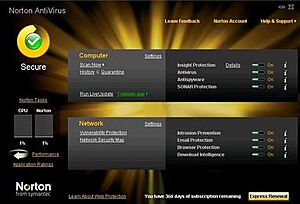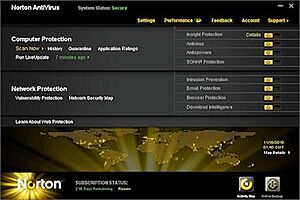Norton AntiVirus facts for kids
| Developer(s) | Gen Digital |
|---|---|
| Initial release | December 1990 |
| Stable release | Windows: 22.21.10.40 (November 1, 2021) |
| Operating system | Microsoft Windows (Windows 95 and later), macOS, Linux |
| Platform | x86, x64 |
| Type | Antivirus |
| License | Commercial proprietary software |
Norton AntiVirus is an anti-virus or anti-malware software product founded by Peter Norton, developed and distributed by Symantec (now Gen Digital) since 1990 as part of its Norton family of computer security products. It uses signatures and heuristics to identify viruses. Other features included in it are e-mail spam filtering and phishing protection.
Symantec distributes the product as a download, a box copy, and as OEM software. Norton AntiVirus and Norton Internet Security, a related product, held a 25% US retail market share for security suites as of 2017. Competitors, in terms of market share in this study, include antivirus products from McAfee, Trend Micro, and Kaspersky Lab.
Norton AntiVirus runs on Microsoft Windows, Linux, and macOS. Windows 7 support was in development for versions 2006 through 2008. Version 2009 has Windows 7 supported update already. Versions 2010, 2011, and 2012 all natively support Windows 7, without needing an update. Version 12 is the only version fully compatible with Mac OS X Lion. With the 2015 series of products, Symantec made changes in its portfolio and briefly discontinued Norton AntiVirus. This action was later reversed with the introduction of Norton AntiVirus Basic.
Contents
Origins
In May 1989, Symantec launched Symantec Antivirus for the Macintosh (SAM). SAM 2.0, released March 1990, incorporated technology allowing users to easily update SAM to intercept and eliminate new viruses, including many that didn't exist at the time of the program's release.
In August 1990 Symantec acquired Peter Norton Computing from Peter Norton. Norton and his company developed various DOS utilities including the Norton Utilities, which did not include antivirus features. Symantec continued the development of acquired technologies. The technologies are marketed under the name of "Norton", with the tagline "from Symantec". Norton's crossed-arm pose, a registered U.S. trademark, was traditionally featured on Norton product packaging. However, his pose was later moved to the spine of the packaging, and eventually dropped altogether.
With the 1998 version 5.0 update, SAM was renamed Norton AntiVirus (NAV) for Macintosh.
Windows/DOS editions
By early 1991, U.S. computers were invaded by hundreds of foreign virus strains and corporate PC infection was becoming a serious problem. Symantec's Norton Group launched Norton AntiVirus 1.0 (NAV) for PC and compatible computers. Ads for the product, with suggested retail $129, featured Norton in his crossed-arm pose, wearing a pink shirt and surgical mask covering his nose and mouth.
Due to bug in the software, the original Norton Antivirus 1.0 does not repair infected files or boot sectors properly. This was fixed when version 1.5 was released in June 1991, along with the addition of the option of installing multiple scan levels of the Norton Antivirus Intercept (later renamed to Norton Antivirus Auto-Protect starting off with Norton Antivirus 3.0 released in September 1993.
Norton Antivirus 2.0 was released in December 1991, and introduced the feature of creating a rescue disk, which would include the partition table, CMOS settings memory information, and boot sector of a hard disk of an MS-DOS computer system. This is very handy in case a virus that its definitions do not detect, overwrite this information or move the boot sector to a different location of the hard disk.
Norton Antivirus 3.0, released in September 1993, introduced a unique feature. Unlike other antivirus software products for MS-DOS and early Windows, which will only notify you to turn off your computer, but continue anyway, Auto-Protect or the main program will scan for viruses in memory before loading themselves. If they find a virus loaded into memory, they will halt the entire computer so that you can't even perform a warm boot (Ctrl+Alt+Delete), So that you can turn off your computer from the power and turn it back on again with a clean, uninfected system disk. Most often, this can either be the rescue disk created, or the original MS-DOS system installation disk, followed by the Norton Antivirus program installation disks. This feature is the safest way to deal with any kind of virus in memory. Norton Antivirus 3.0 is also the first version for Windows 3.1.
Product activation was introduced in Norton AntiVirus 2004, addressing the estimated 3.6 million counterfeit Norton products sold. An alphanumeric code is generated to identify a computer's configuration, which ties in with the product key. Users are allowed to activate their product five times with the same product key. Spyware and adware detection and removal was introduced to the 2005 version, with the tagline "Antispyware Edition". The tagline was dropped in later releases. However, Norton AntiVirus 2009 Classic does not include spyware or adware detection. The Classic edition is marketed alongside Norton AntiVirus 2009, which does include spyware and adware detection.
Existing users of the 2006, 2007, 2008, and 2009 versions can upgrade to the latest 2010 version without buying a new subscription. Upgrading will preserve the number of days left on a user's subscription.
Version 2006 (13.0)
The redesigned main graphical user interface aggregates information in a central user interface. CNET reports the Norton Protection Center, while useful, attempts to advertise additional products. To further facilitate detection of zero-day malware, Bloodhound disassembles a variety of programming languages, and scans code for malicious instructions using predefined algorithms. Internet Explorer homepage hijacking protection was introduced in this release as well; however notably missing is search engine hijacking protection. CNET highlighted Norton AntiVirus 2006's noticeable impact on system performance.
Operating system requirements call for Windows 2000 Service Pack 3 or Windows XP. 150 MB of free space and a 300 MHz processor is required under either operating system. 128 MB of RAM is required under Windows 2000, while 256 MB is required in Windows XP.
Version 2007 (14.0)
Norton AntiVirus 2007 was released on September 12, 2006. Symantec revised Norton AntiVirus with the goal of reducing high system resource utilization. Windows Vista compatibility was introduced in this release as well. Despite having about 80% of the code rewritten, CNET reports mixed results in performance testing.
Windows 2000 compatibility was dropped from this release. Compatibility with 32-bit versions of Windows Vista was added to this release with a patch from Symantec. Hardware requirements under Vista call for 150 MB free space, an 800 MHz processor and 512 MB RAM. Requirements under Windows XP similarly call for 150 MB free space, a 300 MHz processor, and 256 MB of RAM.
Version 2008 (15.0)
Norton AntiVirus 2008 was released on August 28, 2007. Emphasizing malware prevention, new features include SONAR, which looks for suspicious application behavior. This release adds real-time exploit protection, preventing attackers from leveraging common browser and application vulnerabilities.
When installed in 32-bit versions of Windows XP Service Pack 2, 300 MB of free space, a 300 MHz processor, and 256 MB of RAM is required. When installed in 32-bit and 64-bit versions of Windows Vista, 300 MB of free space, an 800 MHz processor, and 256 MB of RAM is needed.
Version 2009 (16.0)
Norton AntiVirus 2009 was released on September 8, 2008. Addressing performance issues, over 300 changes were made, with a "zero-impact" goal.Benchmarking conducted by Passmark Software PTY LTD highlights its 47-second install time, 32 second scan time, and 5 MB memory utilization. Symantec funded the benchmark test and provided some scripts used to benchmark each participating antivirus software.
The security status and settings are now displayed in a single main interface. A CPU usage monitor displays the total CPU utilization and Norton's CPU usage in the main interface. Other features include Norton Insight, a whitelisting technology which cuts scanning times by mapping known safe files using information from an online database. To address malware response times, updates are delivered every 5 to 15 minutes. However, such updates are not tested by Symantec, and may cause false positives, or incorrectly identify files as malicious. The exploit scanner found in the 2007 and 2008 versions was dropped from this release.
When installed in 32-bit versions of Windows XP Service Pack 2, 150 MB of free space, a 300 MHz processor, and 256 MB of RAM is required. When installed in 32-bit or 64-bit versions of Windows Vista, 150 MB of free space, an 800 MHz processor, and 512 MB of RAM is required.
Two variations on Norton AntiVirus 2009 are also marketed by Symantec. The Gaming edition provides finer control over when Norton downloads updates and allows components of the suite to be disabled either manually or automatically when the computer enters full-screen mode. The Classic edition cannot find or remove adware and spyware.
Version 2010 (17.0)

Version 17.0 was released on September 9, 2009. Several features have been updated in this release, including SONAR, now dubbed SONAR 2. It now uses more information to determine if an application is truly malicious. Norton Insight can present users with information about the origins, activities, and performance of applications along with reputation data. A new feature codenamed Autospy helps users understand what Norton did when malware was found. Previous releases removed threats on sight and quietly warned users, potentially confusing when users are deceived in downloading rogue security software. Much of this information is placed on the back of the main window; a toggle button switches between the sides. Symantec has also added Windows 7 support. Aside from that, Symantec has also added the Norton Download Insight to prevent drive by drive downloads.
Version 2011 (18.0)

Version 2012 (19.0)
Version 2013 (20.0)
Version 2014 (21.0)
Lack of 2015 version
Symantec briefly discontinued the standalone Norton AntiVirus product in 2015 instead replacing it with Norton Security.
Version 2016 (22.0)

Macintosh edition
Norton AntiVirus 11 for Mac introduced support for Mac OS X v10.5 Leopard platform, with the capability to detect both Macintosh and Windows malware. Other features include a vulnerability scanner, which blocks attackers from leveraging software exploits. Norton AntiVirus 11 also includes the ability to scan within compressed or archived files, such as Time Capsule volumes. Operating requirements call for Mac OS X Tiger. A PowerPC or an Intel Core processor, 128 MB of RAM, and 100 MB of free hard disk space are also required. Norton AntiVirus Dual Protection for Mac is intended for Macintosh users with Windows running on their systems, using Boot Camp or virtualization software such as VMware Fusion. It provides a license for both Norton AntiVirus 11 with Norton AntiVirus 2009.
Comparison with other software
From the 2009 to 2012 editions, Symantec made huge changes to their products' speed and performance. Norton products now have only 2 running processes, using about 24 MB of RAM. As soon as a virus is recognized, information in regards to the virus (a virus signature) is stored in a pandemic definitions file, which contains the vital know-how to become aware of and get rid of the virus. According to tests sponsored by Symantec, PassMark Security Benchmark 2012 Norton AntiVirus and Norton Internet Security are the lightest suites available. Av-comparatives.org also tested these products and gave similar results. PCMag recognises 2011 and 2012 lines as the fastest and strongest in protection. PCWorld's tests of security software put Norton Internet Security 2009 in the 1st place. In 2011, in a test of PCWorld, Norton Internet Security was the winner. Dennis Technology Labs (in tests sponsored by Symantec) confirms the performance and effectiveness of Norton 2011 and 2012 lines.
Norton AntiVirus vs. GCSB Amendment Bill
On 14 August 2013 the Prime Minister of New Zealand John Key addressed what he identified as "misinformation" surrounding the GCSB Amendment Bill, claiming that the actions of the Government Communications Security Bureau were analogous to Norton AntiVirus.
See also
 In Spanish: Norton AntiVirus para niños
In Spanish: Norton AntiVirus para niños
- Internet security
- Comparison of antivirus software
- Comparison of firewalls


